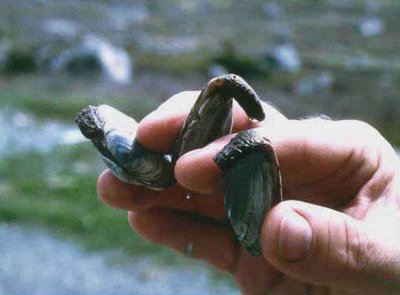April 8, 2005
Paralytic shellfish toxins cause mutation that allows clams to accumulate 100 times more toxin
Exposure to toxins that cause paralytic shellfish poisoning can result in a mutation that makes some clams much more resistant to the toxin, which can result in a greater danger to humans, according to a study published this week in the journal Nature. Paralytic shellfish toxins (PSTs) are produced by algae that appear in certain coastal areas in the United States in an event known as an algal bloom, commonly called a “red tide.” People who eat clams exposed to the PSTs can suffer the paralytic effects of the toxins, and there is no cure for the poisoning.
Researchers found that softshell clams in areas frequently affected by harmful algal blooms are more resistant to PSTs than clams from other areas. Earlier work had shown that the toxins block the function of the sodium ion channel, a molecular switch that generates the nerve impulse and therefore is vital to neural and muscular activity. What researchers did not know was why some clams were more resistant than others.
The collaborative team of scientists from Washington, Maine, and Nova Scotia determined that the toxins cause a small mutation that prevents them from binding to the sodium ion channels in the clam’s nerve tissue. Instead of binding to the ion channels and causing paralysis and later death, the toxins build up in the clam, accumulating about 100 times more toxin than in clams without the mutation. The resistance allows them to continue feeding during the harmful algal bloom and accumulate levels of toxins that increase risk of paralytic shellfish poisoning in humans.
Scientists and public health officials knew that clams carrying the toxins could survive after an algal bloom, which is why clams are tested well after a “red tide” event to reduce the risk of poisoning in humans. But no one knew until now why the clams were accumulating the toxins.
“It is quite surprising that the toxins could serve as selective agents for a mutation in the sodium ion channel, and that the mutation can prevent toxin binding without otherwise changing the function of the ion channel,” said Dr. William Catterall, professor and chair of pharmacology at the University of Washington School of Medicine in Seattle, one of the paper’s co-authors.
The research was conducted by a collaborative team of scientists from the University of Washington and the National Oceanic and Atmospheric Administration Northwest Fisheries Science Center in Seattle, the University of Maine, and the Institute for Marine Biosciences in Halifax, Nova Scotia.
Scientists hope that identifying this mutation will help them develop a genetic marker for breeding shellfish stocks that accumulate little or no PSTs in regions affected by harmful algal blooms, thereby reducing paralytic shellfish poisoning incidents and clam harvest losses.
###



